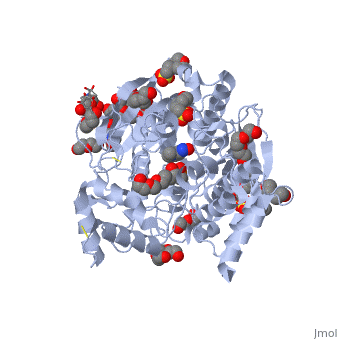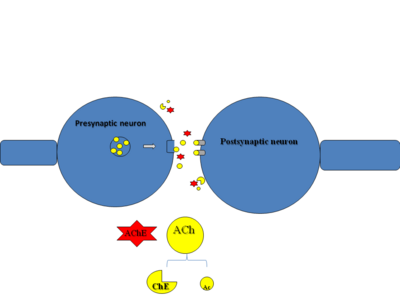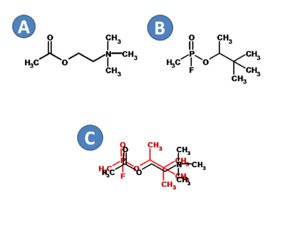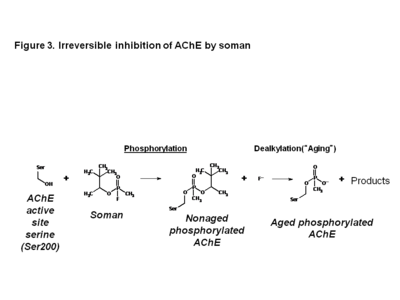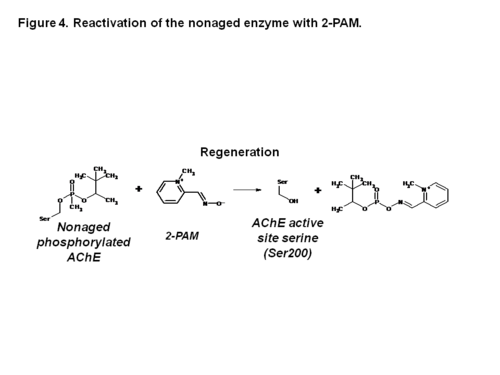Acetylcholinesterase inhibitors
From Proteopedia
Acetylcholinesterase (AChE) is an enzyme that catalyses the hydrolysis of the neurotransmitter acetylcholine (ACh) to acetate and choline, and plays a crucial role in terminating the nerve impulse at cholinergic synapses. Reversible inhibitors of AChE are used to treat diseases such as Alzheimer’s disease (AD) and Parkinson’s disease (PD). Conversely, irreversible inhibition of AChE by organophosphates (), such as soman, can lead to death. In this process, the OP covalently attaches to a in the active site to generate a . Subsequently, the OP is dealkylated, a process that is termed aging, generating a form of the enzyme that cannot be reactivated by antidotes, such as pralidoxime (2-PAM). Recently, the structures of Torpedo californica (Tc) AChE conjugated with soman, in both the non-aged and aged forms, and 2-PAM have been solved. From these structures, it is clear that a structural reorientation of His440, a component of the active site, occurs during the aging process. Additionally, the structure of the ternary complex of the aged AChE complex with , revealed that the oxime functional group is not optimally positioned for nucleophilic attack on the phosphorous atom.[1] ACh is a neurotransmitter that is essential for nerve transmission at the cholinergic synapse (Figure 1). In the beginning a nerve impulse reaches the presynaptic membrane which acts upon vesicles that contain ACh. Then ACh is released into the synapse. Afterwards, ACh diffuses across the synapse where it binds and activates receptors on the postsynaptic neuron. As a result a nerve impulse is initiated. It is also important to terminate the impulse by breaking down ACh into acetyl and choline portions by AChE. AChE is a very fast enzyme[2] and even though the active site is at the bottom of a deep (~20 Â) and narrow (~5 Â) gorge [3], it has several features that ensure rapid catalysis.[4] Primarily, 1. 14 aromatic residues line the active site [5] and filter ACh, by cation-π interactions, from the surface of AChE to the (Ser200, Glu327 and His440).[6] 2. AChE has a dipole that helps "attract" to the active site [7] Low levels of Acetylcholine Due to the decrease in levels of ACh found in patients with Alzheimer's Disease (AD) and Parkinson's disease (PD) there is a need to increase the amount of ACh available in the post-synaptic neuron. By reversibly inhibiting AChE it is possible to stop the breakdown of ACh and thereby increase its levels at the synapse. Therefore AChE is the target of reversible therapeutic agents that treat AD and PD. These agents include-donepezil, rivastigmine and galantamine.[8] There are certain agents that are able to bind to AChE in an irreversible manner. These agents are from a class of organophosphates (OP) and include insecticides and chemical warfare agents such as Malathion and Echothiophate. When the reaction becomes irreversible it can ultimately lead to a person's death, unless treated right away. The way OP poisoning is treated with nucleophilic reactivators such as 2-PAM.[8] OPs are irreversible inhibitors of AChE and are used as both insecticides and chemical warfare agents. The chemical structures of ACh and soman have tremendous similarity, revealing why soman reacts with AChE so efficiently (Figure 2). The chemical structures of ACh and soman are very similar. A) chemical structure of ACh. B) chemical structure of soman. C) superimposition of the chemical structure of soman with the chemical structure of ACh. ACh is in black colored text and soman is in red colored text.
The irreversible inhibition of AChE by soman is a multi-step process [9] (Figure 3). First, the catalytic serine residue (Serine 200) performs a nucleophilic attack on the phosphorus atom of soman, generating the phosphorylated enzyme. Second, the pinacolyl group departs, which signifies “aging.” At this point, Aged phosphorylated AChE can not be reactivated. [10]
Antidotes to Treat OP Poisoning 2-PAM is a nucleophile that can reactivate non-aged form of the enzyme. Before aging occurs, reactivation of AChE can occur through nucleophilic attack of the oxime group of 2-PAM on the phosphorus atom of the phosphonyl adduct, resulting in its cleavage from Ser 200. [12]
Figure 5* shows a detailed image of the interaction among different molecules and their respective positions in Acetylcholinesterase.
Next Generation Antidotes for OP Poisoning As described above, 2-PAM could reactivate nonaged AChE, however aged AChE enzyme at present can not be reactivated. Therefore, scientists are trying to find new reactivators that will fill that niche. Structure of 2-PAM could help in the synthesis of the “ideal” reactivator because it contains a positive and negative charges. The reactivator has to be able to overcome the negative charge of the Oxygen and at the same time act as a nucleophile on the Phosphorus at close proximity and proper orientation which currently seems difficult but possible at least in theory. [8] .[14] Besides 2-PAM, there are other reactivators. These oximes are usually elongated and assumed to connect PAS (Peripheral anionic site, found on top of the gorge) and CAS (unlike 2-PAM and Soman/ TcAChE which is only seen in CAS). They include Decamethonium and heptylene linked bistacrene which are longer but act in a similar mode to the Oximes. [15]
Summary AChE terminates nerve transmission at the cholinergic synapse by breaking down the neurotransmitter ACh into acetate and choline. AChE is a target for therapeutic agents to treat maladies such as ADs. It is also the target for nerve agents such as soman. Soman irreversibly inhibits AChE. Initially, soman covalently attaches the active site serine nucleophile. Before dealkylation of the OP adduct, the active site serine can be reactivated with 2-PAM. However, once dealkylation has occurred (“aging”), 2-PAM is ineffective. 2-PAM’s Oxime group points towards His440 Oxygen, away from Soman Phosphorus at a distance of 6.8 Å. [16] It is also on the wrong side for direct nucleophilic attack on the P-Ser 200 O γ bond. Therefore better reactivators have to be developed that would be closer to Soman’s Phosphorus thereby helping with reactivation.[17] Ideally, there could be an agent that would neutralize OPs even before they inactivate AChE. In theory that agent would have a better chance of protecting AChE because it would not need to be reactivated since this agent would not let OP bind to AChE. Currently it seems that this agent is PON1, serum paraoxonase, however more research has to be done in order to see its interaction with all/most OP.
Acknowledgements Professor Joel L. Sussman, Weizmann Institute of Science Professor Lars Westblade, Touro College of Pharmacy Naomi Arye, Touro College of Pharmacy Yakov Fattakhov, Touro College of Pharmacy Hostos-Lincoln Academy SMART Team 2009-10*
References
| |||||||||||
